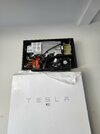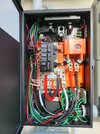I'm hoping that my solar install (ordered last July) will actually start happening, so I'm reading up a bit. The instructions on connecting to the solar inverter only speak of WiFi. I have WiFi of course, but I've also run Ethernet to various places around the house, and running one to the place in the basement where the Powerwalls and inverter will be would be no big deal. I could install a jack before they get here. Does the inverter have a place to connect an Ethernet cable? Does it add any complications? Simplify anything?
Thanks!
RH in CT
Thanks!
RH in CT




